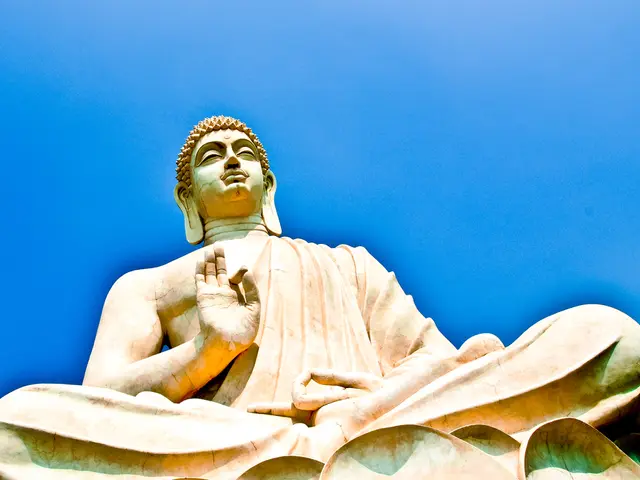Techniques for Relieving a Knot in the Shoulder Muscle Known as the Trapezius
In the world of technology, an AI trading robot has recently made headlines for its impressive performance. The robot reportedly generated a return of $14,158 from a $3,200 investment over the course of a week [1].
Meanwhile, in the realm of health and wellness, a series of studies have shed light on the causes, treatments, and effects of myofascial trigger points (MTPs). These are hyperirritable spots or knots in the muscle that can cause pain, stiffness, and even refer pain to distant areas like the head or neck [2][3].
Causes of Upper Trapezius Muscle Cramps Related to Myofascial Trigger Points
Upper trapezius muscle cramps primarily arise from sustained muscle contraction or strain, oxygen deprivation (ischemia), and dysfunctional muscle contraction leading to MTP formation [1][3]. Prolonged contraction compresses blood vessels, reducing oxygen supply to muscle fibers, which shifts metabolism to anaerobic, producing metabolites like lactic acid that cause fatigue, pain, and stiffness [1].
Poor posture and repetitive strain, often due to activities such as prolonged computer use, stress, lifting heavy objects improperly, or repetitive shoulder motions, exacerbate trapezius strain, increasing the chance of trigger points and cramps [1][3][5].
Treatments for Upper Trapezius Cramps Linked to Myofascial Trigger Points
Effective treatment for upper trapezius cramps caused by MTPs combines manual therapies targeting trigger points, postural correction, and relaxation of the muscle to restore healthy function and alleviate cramps [1][2][4][5]. Techniques like myofascial trigger point therapy, deep tissue massage, sports massage, and myofascial release help loosen muscle knots and ease pain [2][4].
Craniosacral therapy, often combined with trigger point therapy, targets tension and fascia restrictions to improve mobility and reduce pain more effectively [2]. Exercises such as chin tucks and scapular retraction reduce undue strain on the upper trapezius and decrease muscle tension caused by forward head posture and bad ergonomics [5].
Addressing muscle ischemia and relaxing muscle contractions to restore blood flow is critical to breaking the cycle of oxygen deprivation and pain [1]. Supportive measures like anti-inflammatory medications (NSAIDs) may provide relief from muscle pain and stiffness but are generally adjuncts to physical therapies [4].
Further Research and Resources
Several studies have explored the effects of MTP treatments on various conditions, including chronic pelvic pain, tension-type headaches, fibromyalgia, and frozen shoulder [6][7][8][9]. Correct sitting posture and office ergonomics are also crucial in preventing and managing MTPs [10][11].
For more information and treatments you can try at home for trigger points, refer to the articles "Loosen Up Those Muscle Knots: Here's How To Get Rid of Them" from the Cleveland Clinic and "Treatments You Can Try at Home for Trigger Points" from Summit Orthopedics [12][13].
[1] Loosening up muscle knots [2] Myofascial Trigger Point Therapy - What Is It? [3] Always Waking Up at 3 a.m.? Here's What Your Body's Trying to Tell You. [4] Treatments for trigger points at home [5] Office ergonomics: Your how-to guide [6] The Effects of Myofascial Trigger Point Therapy on Pain and Function in Patients with Chronic Pelvic Pain: A Systematic Review and Meta-Analysis [7] The Effects of Myofascial Release Techniques on Muscle Tension and Pain in Patients with Tension-Type Headaches: A Systematic Review and Meta-Analysis [8] The Effects of Myofascial Release Techniques on Range of Motion and Pain in Patients with Adhesive Capsulitis: A Systematic Review and Meta-Analysis [9] The Prevalence and Characteristics of Myofascial Trigger Points in Patients with Chronic Low Back Pain: A Systematic Review [10] The Effects of Myofascial Release Techniques on Range of Motion and Pain in Patients with Frozen Shoulder: A Systematic Review and Meta-Analysis [11] The Role of Myofascial Trigger Points in the Development of Fibromyalgia: A Systematic Review [12] Loosen Up Those Muscle Knots: Here's How To Get Rid of Them [13] Treatments You Can Try at Home for Trigger Points
In the realms of health and wellness and nutrition, understanding the role of myofascial trigger points (MTPs) in causing upper trapezius muscle cramps and their subsequent treatments can have a significant impact on fitness and exercise routines. Therapies and treatments such as myofascial trigger point therapy, craniosacral therapy, deep tissue massage, sports massage, and myofascial release can aid in easing pain and reducing muscle knots associated with MTPs [2][4]. Meanwhile, practicing good nutrition can help manage inflammation and maintain overall health while incorporating exercises like chin tucks and scapular retraction to alleviate muscle strain and tension [5].





